
In this crouched position note the legs spread shoulder width apart, the rear bag supporting the front, and the support hand placement pulling the rifle slightly back into the fence.
Read Part 1: Intro to Precision Rifle Series — Mindset, Equipment & Skills
Without a doubt, some of the most dreaded stages during precision rifle (PRS) competitions are where you have to get up from the prone and shoot from a barricade of some type. Hardly anyone likes them, the stages often force the shooter into awkward, unstable positions that fly in the face of what’s good for accuracy and precision. To be able to successfully complete a barricade stage requires a good understanding of the fundamentals of marksmanship as well as an ability to adapt on the fly. For that reason, to be good at shooting from a barricade requires practice to get your body used to the positions and find what works for you.
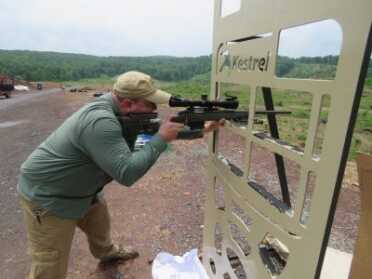
You want to try to avoid direct contact like this between the stock and the barricade. Pad the front with a rear bag or dedicated barricade bag.
Categories
Barricades can take many forms, some of which may be constructed from things the shooter had never considered shooting from before. Based on my experience you can break barricades down into three basic categories, which can help you focus your approach to each one. It’s a fundamental principle that the lower you are to the ground the more stable you are going to be and that’s mostly true when shooting from barricades also. The ultimate position that I choose to shoot from a barricade is going to be guided by the speed and accuracy that I need as well as the target distance. Those three things can work both for and against each other so it’s a constant give and take; the key is finding the right balance.
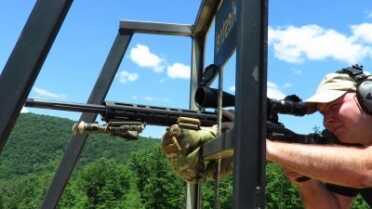
A dedicated front bag like the Armageddon Gear Game Changer is perfect for barricades like the one above.
To get speed sometimes you have to be a little unstable and with small targets that are far away, that can mean missing targets. Conversely, if you take too much time getting into a position to get very stable on targets that are relatively generous you could time out and the end result is the same, you miss targets. It’s always about how much can I get away with? If I’m getting a stage briefing and I’m noticing that all the targets are pretty close, say 350 yards and in, I’m probably going to gravitate towards a standing or kneeling position off the barricade. This is especially true if a majority of the targets are pretty generously sized where I don’t have to be super accurate. Now, if my targets are beyond 400 yards and they’re less than 2 MOA in size I’m definitely going to be looking at a more stable sitting or kneeling position. It’s better to take an extra 10 seconds or so in that situation to get really stable and bang the targets out in under 40 seconds then get into a hasty position and spend the next 85 seconds chasing rounds.

Pushing the rifle to the corner of a barricade and trapping it with the support hand greatly aid in stability.
Technique
It is a fact of life that in these positions you are going to get some wobble, where the crosshairs are moving all over the target. Our goal though is to reduce that wobble to the point where we can keep the reticle within the confines of the target itself. Shooting position wise, there are some fundamental things that you can do to get more stable. One of the first is to use something to pad the front of the rifle so that you don’t have hard surface or surface contact between the rifle and barricade. This can be your rear bag, a dedicated barricade pad, or a number of the other commercial support bags on the market. You also want to try to get as much bone support as possible when shooting, especially in the kneeling and sitting positions. For example, in the kneeling, instead of taking up a standard kneeling position with the support side leg up to support the weak side elbow, reverse it. Lift the firing side leg so that it can support the strong side elbow and provide more stability since the barricade is supporting the front of the rifle. If you have to shoot from a standing position at the barricade it helps to spread your legs a little wider than shoulder-width apart, square up to the target and lean in slightly. Not so much that you start to move the barricade around but just enough to put a little pressure on the gun, this is called loading. Loading up the rifle pushes it slightly into the barricade and will help manage recoil and stay on target better for any necessary follow up shots.
Gear
There are some products available that can help you perform better at a barricade such as the Armageddon Gear Game Changer Bag and Armageddon Gear Fat Bag. When used in conjunction with each other these two bags can provide a great amount of stability for the shooter in various positions. The Game Changer bag is designed to be a multipurpose support bag that wraps and conforms to a surface to provide a stable platform for the front of the rifle. The Fat Bag is designed to go under the strong side arm to give it more support and let the shooter relax when they are in position. Like many other bags, it comes with a lanyard and carabiner so that it can be attached to the shooter to keep it close at hand. Personally, I like to ditch the lanyard and use the carabiner to clip the bag directly to my belt loop on my firing side. This does two things, one it keeps the bag from swinging around so much when I’m running and it helps get the bag into position faster when I get to where I’m going. What I mean is that when I get to my firing position I don’t have to pull on the whole lanyard to get to the bag, I just reach down to my side and lift it up into position.
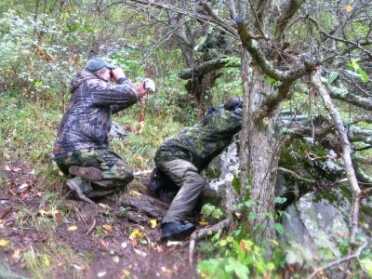
Off of natural barricades like this rock, try to get in as much contact with the object as possible.
Natural Barricades
As I said before I categorize barricades into three basic categories, natural, traditional, and non-standard barricades.
Natural barricades are of course those things you would find in nature such as rocks, logs, and trees, which I’ve encountered during many match stages. The exact position is going to depend on the characteristics of the object itself but it’s generally a good idea to get as much of your body in contact with it as possible.
On large rocks or logs, lean into them if possible to give yourself some stability and try to get the rifle in as much contact with the object as possible. Deploy the bipod legs for front support and use a rear bag if you can but at the very least use a front bag to support the front of the gun.
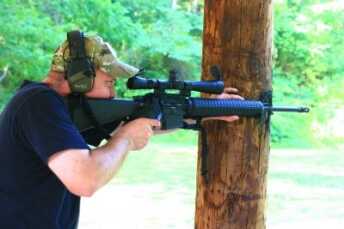
Off a vertical object like a tree or post using a C-grip to pinch the front of the rifle can be more stable than freehanding the rifle.
If you have to shoot from a standing tree, a technique that I’ve found that works well is to push the palm of my support hand into the tree, creating a “C” with my thumb and fingers. Let the rifle rest in the “C”, lightly grasp the forend, and push slightly forward with the rifle to load it up. I have used this technique to shoot while standing up, leaning against a tree, and it helps, obviously it’s not the most stable, but it’s better than free handing it.
Traditional Barricades
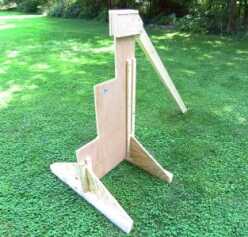
A simple barricade such as this one cost less than 50 dollars to make but creates an exceptional training tool for precision rifle matches.
Traditional barricades are going to be the ones you are probably most familiar with that are stepped at different intervals to look like a set of stairs. Obviously due to the nature of these barricades you aren’t going to be able to get as much body contact as you would with some of the natural types of barricades. In these instances, you are going to want to use loading and bone support as much as possible to help stabilize the rifle. Of course, if you have some of those commercial bags those are going to help a whole lot too.
Non-Standard Barricades
Non-standard barricades are being seen more and more in matches to mix things up and they can pretty much be made from anything. I’ve encountered wooden tank traps, roof simulators, old wire spools, feed barrels, and even ratchet straps strung between two trees. The diverse nature of these types of barricades makes it tough to have a standardized approach to them so it may require a bit of improvisation to make it work. Many of the fundamentals still apply though and where you can get bone support, take it, where you can get in contact with the barricade, use that to your advantage.

A good example of a non-standard barricade and some of the challenges that it can pose. Note the rear bag at the front padding the forend.
I know that when I’ve had to shoot from a ratchet strap, even if it is pulled tight, there is still some slack created by the rifle’s weight. The best method that I’ve found is to hook the strap with the bipod and push forward to load the rifle and as always square up to the target. If you have a tripod that can be set up to help you steady the rear of the rifle by keeping it next to you and holding on to one of the legs to support the butt.
If you find yourself having to deal with an obstacle like the blue feed barrels or a wire spool that’s on its side to make a table top there are a couple things you can do to make yourself more stable. Generally, when setting up a precision rifle it’s a good idea to get the bipod out as far as it will go but in these situations, it can be beneficial to mount the bipod farther back. Moving the bipod towards the magazine moves the rifle’s center of gravity closer to the barrel’s center and helps with stability. I can also get in more contact with the barrel since I’m closer to it and I can rest my arms on the top to put more weight on it. Like I said, there’s no set way to deal with a non-standard barricade or obstacle but don’t be afraid to use your imagination a little a bit.
Parting Thoughts
I hope this article gave you an understanding of the thought processes that I use to approach certain barricades and help you when you encounter them yourself. I’ve seen a variety of methods used to negotiate and shoot around barricades at matches, some of them were pretty good and others not so much. If you stick to some of the fundamental principles that I talked about though you’ll do just fine. My advice is to try and avoid trying a new method for the very first time when it’s your turn at the stage and the shot timer just went off. If you see another competitor try something new, take note of it and try it out for yourself, later on, to see if it would be truly effective for you.

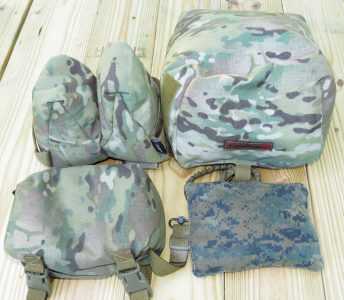

Its a great idea, because not all shooting situations are not picture perfect.